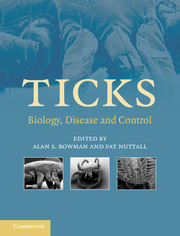Book contents
- Frontmatter
- Contents
- List of contributors
- Preface
- 1 Systematics and evolution of ticks with a list of valid genus and species names
- 2 The impact of tick ecology on pathogen transmission dynamics
- 3 Tick salivary glands: the physiology of tick water balance and their role in pathogen trafficking and transmission
- 4 Tick saliva: from pharmacology and biochemistry to transcriptome analysis and functional genomics
- 5 Tick toxins: perspectives on paralysis and other forms of toxicoses caused by ticks
- 6 Tick lectins and fibrinogen-related proteins
- 7 Endocrinology of tick development and reproduction
- 8 Factors that determine sperm precedence in ticks, spiders and insects: a comparative study
- 9 Tick immunobiology
- 10 Saliva-assisted transmission of tick-borne pathogens
- 11 Lyme borreliosis in Europe and North America
- 12 Viruses transmitted by ticks
- 13 Babesiosis of cattle
- 14 Theileria: life cycle stages associated with the ixodid tick vector
- 15 Characterization of the tick–pathogen–host interface of the tick-borne rickettsia Anaplasma marginale
- 16 Emerging and emergent tick-borne infections
- 17 Analysing and predicting the occurrence of ticks and tick-borne diseases using GIS
- 18 Acaricides for controlling ticks on cattle and the problem of acaricide resistance
- 19 Anti-tick vaccines
- 20 Anti-tick biological control agents: assessment and future perspectives
- 21 Pheromones and other semiochemicals of ticks and their use in tick control
- Index
- References
3 - Tick salivary glands: the physiology of tick water balance and their role in pathogen trafficking and transmission
Published online by Cambridge University Press: 21 August 2009
- Frontmatter
- Contents
- List of contributors
- Preface
- 1 Systematics and evolution of ticks with a list of valid genus and species names
- 2 The impact of tick ecology on pathogen transmission dynamics
- 3 Tick salivary glands: the physiology of tick water balance and their role in pathogen trafficking and transmission
- 4 Tick saliva: from pharmacology and biochemistry to transcriptome analysis and functional genomics
- 5 Tick toxins: perspectives on paralysis and other forms of toxicoses caused by ticks
- 6 Tick lectins and fibrinogen-related proteins
- 7 Endocrinology of tick development and reproduction
- 8 Factors that determine sperm precedence in ticks, spiders and insects: a comparative study
- 9 Tick immunobiology
- 10 Saliva-assisted transmission of tick-borne pathogens
- 11 Lyme borreliosis in Europe and North America
- 12 Viruses transmitted by ticks
- 13 Babesiosis of cattle
- 14 Theileria: life cycle stages associated with the ixodid tick vector
- 15 Characterization of the tick–pathogen–host interface of the tick-borne rickettsia Anaplasma marginale
- 16 Emerging and emergent tick-borne infections
- 17 Analysing and predicting the occurrence of ticks and tick-borne diseases using GIS
- 18 Acaricides for controlling ticks on cattle and the problem of acaricide resistance
- 19 Anti-tick vaccines
- 20 Anti-tick biological control agents: assessment and future perspectives
- 21 Pheromones and other semiochemicals of ticks and their use in tick control
- Index
- References
Summary
INTRODUCTION
Almost two millennia ago, the wonders of tick osmoregulation and excretion were commented upon by Pliny the Elder (AD 23–79) in his 37-volume Historia Naturalis when he wrote: ‘a tick simply filled to bursting point with its victim's blood and then died because it had no anus’ (from Hillyard, 1996). A millennium and a half later, the Reverend Dr Thomas Moufet (1553–1604) also noted in his Insectorum sive Minimorum Animalium Theatrum that ‘[Ricinus] is filled with food abundantly and yet there is no passage for any excrement’. Quite correctly, these ancient natural historians observed the tremendous increase in body size of feeding female ticks and then suddenly these engorged ticks would detach and fall to the ground, barely able to move with their enormous rounded bodies, and unwilling to reattach. However, the conclusions of Pliny and Moufet were incorrect that this apparent onset of tick ill-health was due to an inability to excrete caused by the lack of anus or that these inactive engorged females would die as a result. Indeed, if Pliny and Moufet had continued their observations of ticks for a few weeks, they would have seen that these engorged females (most likely Ixodes ricinus) would deposit several thousand eggs before dying, thus completing the life cycle. Ticks do possess an anus and excrete a small amount of nitrogenous waste (mainly guanine).
- Type
- Chapter
- Information
- TicksBiology, Disease and Control, pp. 73 - 91Publisher: Cambridge University PressPrint publication year: 2008
References
- 9
- Cited by



